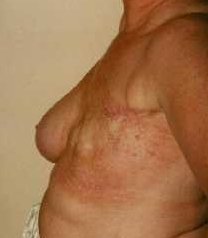
Breast Reconstruction
The physical and emotional strain of losing a breast is immense. It is very easy to be overpowered and lose confidence in yourself. This is temporary and you can change your focus.
There is the option of breast reconstruction which is currently considered by only a relatively small number of mastectomy patients.
I hope through this "exposť" to encourage more women to take the step, to heal the emotional and physical scars caused by a mastectomy and take control of rebuilding a full and confident life.
Reconstruction came to my mind at the time of my mastectomy. A nurse at the hospital confided in me that she was to have her reconstruction the following week, after a twelve month wait. She was positive and excited at the prospect. My mind was stimulated.
My Plastic/Reconstructive surgeon is Mr. Simon Thomson, Hobart, Tasmania, Australia, a wonderfully warm and friendly person with whom I felt instantly at ease. I am deeply grateful to him for returning me to being a whole person again, psychologically as well as physically. He could never imagine the enormity of my gratitude. I had never been aware of just how much I loved my breasts until I lost one!
Due to the extent of damage to my skin from the radiotherapy, the date for reconstruction was set for June 22nd. 2000, eighteen months after my mastectomy and exactly twelve months after the final radiotherapy.
These photos were taken by Mr Thomson just before I went into surgery. The damage from the radiation is clearly visible, as is the deep scar tissue resulting from the mastectomy.

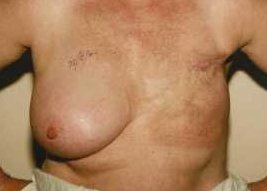
There are a number of different procedures available and the choice is dependant on the lifestyle suitability.
In my case the Free Tram Flap was the choice. This procedure involves the removal of one rectus abdominis muscle from the abdomen. This is the vertical muscle developed in sit-ups to give the flat rippling abs we all admire! The muscle is completely detached from the body along with its artery and vein. Part of the muscle forms the new breast and the artery and vein are connected at a point in the chest. In my case the attachment was to be under the third rib, part of which was removed to give access.
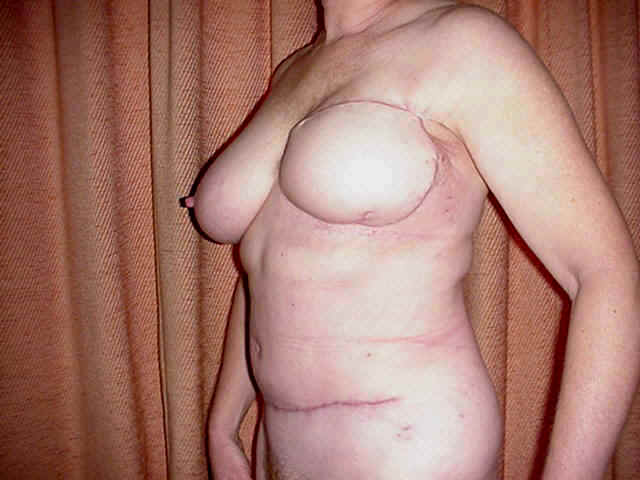
The skin from the tummy was used to replace the radiation- scarred skin and be the covering for the breast. A bonus to having a breast again is a wonderfully flat stomach. In the photo my old tummy button is just visible under the new breast. The scar will fade with time. Some damaged skin is visible as a shadow around the new breast.
Because a major muscle has been removed it is necessary to wear an elastic brace for some time until sufficient cell growth takes place through the mesh implant inserted in place of the muscle. Care needs to be taken as herniation can easily occur.
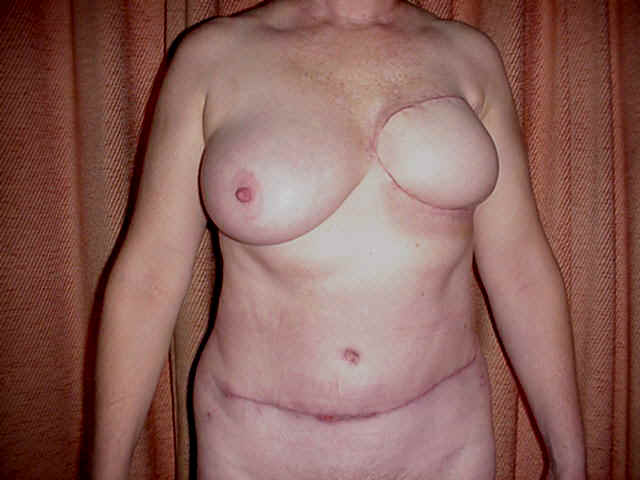
As seen in the pics, four weeks after the operation, the healing was extensive. My tummy button is a new creation. The lopsided look won't last!
I was never confined to bed after leaving the hospital although I did rest during the day to help with the healing process.
I have felt just wonderful throughout this procedure. I have not felt any pain. My spirits are buoyant and all in all it has been a really positive experience. I met some wonderful nurses in the plastics unit who were like a breath of fresh air, so buoyant and supportive. My surgeon Simon, I treasure.
Come November 2000, I hope the final touches will be done in a second operation. A nipple will be constructed and tattooed to colour and the right breast will balanced to the new one. I am really excited about this final step in what has been a long 2 years.
Operation details for Reconstructive Surgery
Hospital: Hobart Private Hospital
Plastic and Reconstruction Surgeon: Mr. Simon Thomson assisted by Dr Tam Dieu.
Time for Surgery: 6 1/2 hours, two surgeons
Hospital Stay: High Dependency Unit 3 days. Ten days in total in hospital. The care was exceptional in every way. Thank-you to the Plastics team, H.D.U. Sr Anna Falkerts and Surgical ward nurses.
Follow up consultation: Fitting a suitable bra, Post operation check. Heart-warming praise for how well I was doing.
November duly arrived, and with it a date for the final stage of reconstruction. I was so excited about this stage that it was as if I was going on a holiday rather than going to the hospital.I waited in my room in my theatre gown for the Anaesthetist to discuss my details and his role in the surgery. When he arrived I was lying down meditating. He walked into the room with a smile and "What? Are you trying to do me out of a job?" I laughed, I knew I was in good hands. Mr Thomson arrived shortly after and set about measuring and marking, plotting the position for the new nipple on the left and the reposition for the right breast which was being reduced to match the left. Photos were taken and I was ready to hop back into bed to be wheeled to the operating theatre.
The operation was around 3 hours.
Forming the nipple A circle measuring the areola size of the right breast was incised on the left breast. Fig A.The centre of the circle was left attached, to be the pedicel for the nipple. The tissue above the nipple site is discarded. Flaps of the tissue below where the nipple would be, (2) were trimmed in a curve and then rotated (3) upward, and stitched into place to form the nipple. The procedure is called a 'skate flap.' I expect because of the likeness to a skate in the sea.
|
|
|
|
|
|
The reduction/graft site A 'T' incision was inscribed under the nipple on my right breast, which was to be reduced. Mr Thomson used the superfluous skin resulting from the reduction to be the donor skin for the areola graft to the left breast, thus avoiding a graft site elsewhere on my body. The circle of tissue was stitched into place around the newly constructed nipple.
My first view of my newly downsized breast was just great. I felt stunned. I had wanted to be back to the smaller size of 10 years earlier for some time. The first view of my new nipple however, was quite overpowering. A miracle was uncovered before my eyes. I felt quite light-headed and really found it hard to believe that what had been gone for 2 years was now magically back.
Hospital Stay: 3 days
The stitches on the left nipple were removed in 6 days. The right reduction stitches were the dissolving type which break down in their own time as the healing progresses.
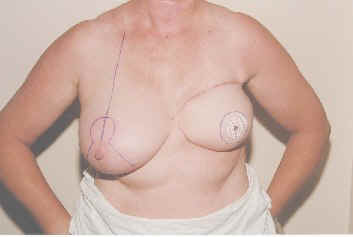
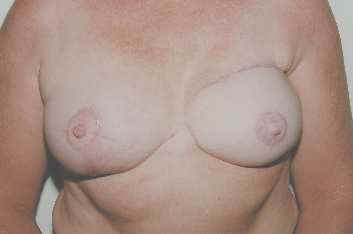
These pics show:
Left: The design for the new nipple and right breast reduction before surgery.
Right: The finished product a couple of months later. You must agree with me a pretty good job
There are a couple of adjustments I would like to make but they are cosmetic I may get around to it one day, but maybe not.
For anyone contemplating reconstruction this feeling of completion is like no other I have ever experienced, deep joy, an incredulous sight, a wholeness and a wiping away of all the trauma that has gone before. I will never forget the sight of the cute little perky nipple looking out again. Fantastic! Each day I smile when I look at the exquisite little construction which makes me complete.
I am deeply grateful to Mr Thomson for the enormous gift he has given me - my physical and psychological wholeness. I find I am unable to put into words the effect on me as a whole except to say I feel lighter, freer and on top of the world.
In recounting my experience of Breast Cancer and Breast Reconstruction, I hope all who read it will gain some strength and comfort knowing that what you are facing is a challenge, not a sentence. You can grow and know that you are a better, wiser and more self aware person than previously.
You can meet the challenge and overcome it, not be just a survivor. The choice is yours.
|
|
Footnote: Denny worked with numerous people through this website and ran a successful face to face workshop on breast cancer through the Cancer Council of Tasmania. Subsequently, Denny took up a career in counselling with Lifeline Tasmania, starting as a volunteer and progressing to the position of trainer of the telephone counsellors. Denny's breast cancer metastasised into bone cancer in December 2009 and after further (unsuccessful) chemotherapy and radiotherapy, she opted to discontinue treatment. She travelled overseas in 2011, did the things she wanted to and opted for palliative care. She remained pain free for the remaining period of her life, while she prepared all her family and friends for her departure. She even organised her own funeral, taking pleasure in selecting the hymns, prayers, photos and music for her service. She had us release doves and insisted we celebrate her life as she was ready to leave. She passed away in September 2012. We, her family, are leaving this site online as a testament to her effort to encourage and assist others. We are very grateful for the excellent care Denny received in the Whittle Ward of the Royal Hobart Hospital and recommend it to anyone wanting to get control of their pain.